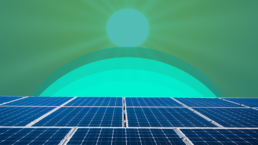Research shows a big improvement in generating capacity per acre of solar panels, with implications for how much land is needed for an energy transition.
By Dan Gearino, Inside Climate News
Utility-scale solar power today is much more efficient than it was a decade ago in how much land it uses, according to new research.
The paper, by lead author Mark Bolinger of Lawrence Berkeley National Laboratory, is timely because utility-scale solar is a big part of plans to make a transition to carbon-free electricity, and because there have been few recent studies about solar’s efficiency in land use.
“It just seems a little bit odd to still be relying on data that was almost a decade out of date,” Bolinger told me.

He found an increase of more than 40 percent in the median generating capacity per acre of solar panels between 2011 and 2019. This includes both “tracking” solar systems, in which the panels shift during the day to follow the sun, and “fixed-tilt” systems, which are stationary. The paper was published in the IEEE Journal of Photovoltaics.
To help put this in more understandable terms, a 100-megawatt tracking solar array would have needed about 600 acres in 2011, but would only have needed about 420 acres in 2019, based on median figures.
That’s a huge shift, which means that the massive deployment of utility-scale solar that is likely to happen in the coming decades will need less land than previously thought.
Recent Posts
Politicians Are Betraying Gen Z On Climate
July 10, 2025
Take Action Now While Gen-Zers thrift, knit, crochet, and find other ways to reduce our footprints, Trump and the GOP are greenlighting more climate…
Trump’s Deportation Threat Against Zohran Mamdani Is Shameful
July 10, 2025
Take Action Now In only half a year of Donald Trump’s presidency, he and his allies have turned deportation into an explicitly political threat…
Teachers Union Votes To Cut Ties To The Anti-Defamation League
July 10, 2025
Take Action Now In a momentous vote, the National Education Association voted to cut all ties with the Anti-Defamation League. The reason? “Despite…
2025 War Abolisher Awards Go To Albanese, Nader, Waters
July 9, 2025
Take Action Now The purpose of the awards is to honor and encourage support for those working to abolish the institution of war itself.By World…




